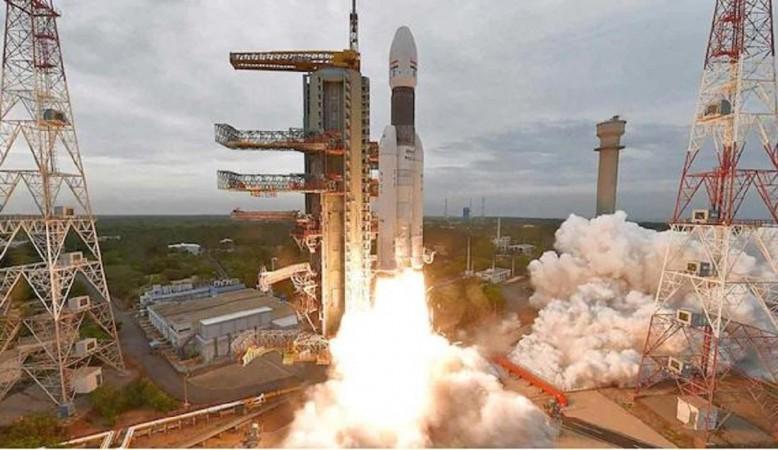The much-awaited GISAT-1 or India's "Eye in Sky" satellite launch suffered a serious setback on Thursday as the GSLV-F10 rocket failed midway. The 2,268-kg Geo-Imaging Satellite-1GISAT-1/EOS-03 communication satellite carried by rocket was also lost.
As planned, the GSLV-F10 three-stage rocket rose into the sky breaking free from the second launch pad of Sriharikota in Andhra Pradesh. The 57.10 metres tall, 416-tonne Geosynchronous Satellite Launch Vehicle (GSLV-F10) lifted off at 5.43 am. The core of the first stage is fired with solid fuel and the four strap-on motors by liquid fuel. The second is the liquid fuel and the third is the cryogenic engine.
Everything went off well till the cryogenic engine got fired at about five minutes into the rocket's flight but in the sixth minute, soon after the cryogenic engine started operation, the mission control centre at the spaceport in Sriharikota tensed up as there was no data coming from the rocket.

The rocket was seen deviating from its plotted path on the screen and soon, the ISRO officials realised that there was a performance anomaly in the flight path.
Chris Bergin of the NASASpaceFlight.com said the GSLV failure during the third stage flight was due to "failed ignition" of what is a cryogenic stage. He tweeted: "2-3 Sep looked fine but the third stage started to roll after ignition and then it progressively worsened. Then the telemetry lines diverged."
The ISRO has confirmed that this mission could not be accomplished as planned. Soon after the mission's failure, K. Sivan, Chairman of ISRO announced it attributing the failure to a technical anomaly in the cryogenic stage. He said: "The mission cannot be fully accomplished because of a technical anomaly observed in the cryogenic stage.
For ISRO, this is the second space mission in 2021 after the successful launch of Brazilian satellite Amazonia-1 by its rocket Polar Satellite Launch Vehicle (PSLV) earlier this year.
Unlike PSLV, GSLV continues to be a naughty boy
Compared to the past record of PSLV rocket launch vehicles, ISRO's Geosynchronous Satellite Launch Vehicle (GSLV) continues to be a naughty boy.
India presently has three fully operational rockets -- the Polar Satellite Launch Vehicle (PSLV) and two GSLV variants -- GSLV-Mk II with a carrying capacity of 2.5 tonnes and GSLV-MkIII with a payload capacity of four ton.

Including Thursday's rocket a total of 18 GSLV's (Mk I, II and III) have been flown of which twelve were successful, six failures (four a total failure and two partial).
The 12 successful launches were in 2003, 2004, 2007, 2014, 2015, 2017, 2018A and 2019, Awhen the rocket launched GSAT-2, Edusat/GSAT-3 an educational satellite, INSAT-4CR, GSAT-14, GSAT-6, GSAT-9, GSAT-6A, GSAT-7A, GSAT-19, GSAT-29, Chandrayaan-2 and one experimental flight (GSLV-MkIII) in 2014.
The ISRO officials had dubbed GSLV in general as naughty boy owing to its unpredictable performance until they were able to stabilise the 'naughty boy' GSLV-Mk II rocket with a carrying capacity of 2.5 ton.
The GSLV's rocket's maiden flight in 2001 (Mark I) was a partial failure as it was not able to sling GSAT-1 into the intended orbit. The satellite could not be raised to the intended orbit later.
Repeated failures but success seen finally
In fact, the 2006 launch was sort of a historic flight for a dubious reason. For the first time, ISRO destroyed the rocket mid-air soon after the lift-off as it started backing up.
However, the 2007 flight gave anxious moments to ISRO officials. Fifteen seconds before the lift-off, the rocket's computers put GSLV on hold, detecting anomalies in the cryogenic fuel stage.
The launch was postponed by two hours to set right the problem even as ISRO officials were considering rescheduling the launch by another two days.
However, the detection of one of the vent valves in the cryogenic engine that had not shut properly led to its immediate rectification.

That apart, ISRO scientists were on tenterhooks till the last moment as for a few seconds during the final cryogenic stage signals from the rocket failed to reach the ground stations.
After a three-year gap, ISRO flew a GSLV in April 2010 with its own cryogenic engine. The mission failed due to the problem in the cryogenic engine's fuel booster turbopump.
Another GSLV went down in December 2010 after it veered off its designated path and exploded mid-air. For the second time a GSLV rocket was destroyed mid-air for safety purposes.
Success in 2014
Even the GSLV-D5 that successfully launched GSAT-14 in January 2014 also gave tension to ISRO officials. Originally it was scheduled for launch on August 19, 2013. Just hours before the blast off the fuel started leaking from its second stage or engine.
According to an ISRO official, the second stage was replaced with a new one built with a different metal. He then said some critical components in the four strap-on motors of the first stage were also replaced as a matter of precaution.










